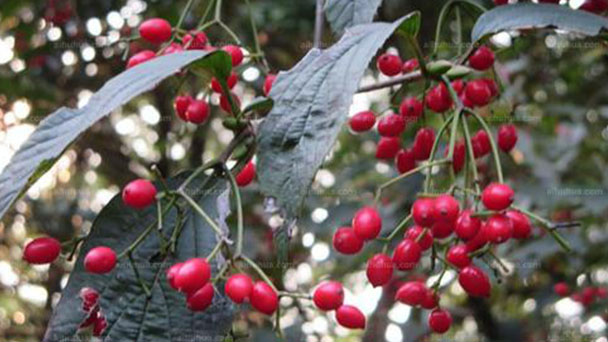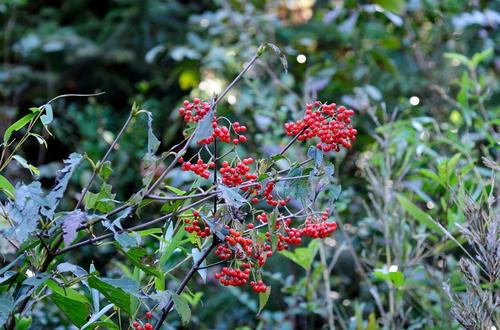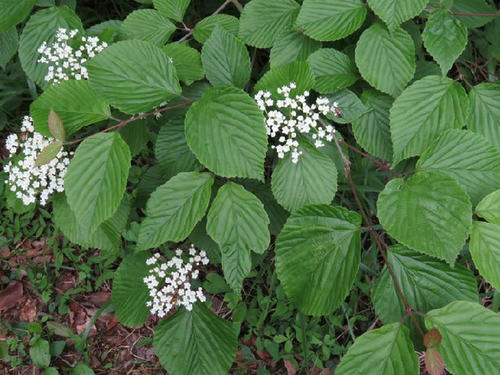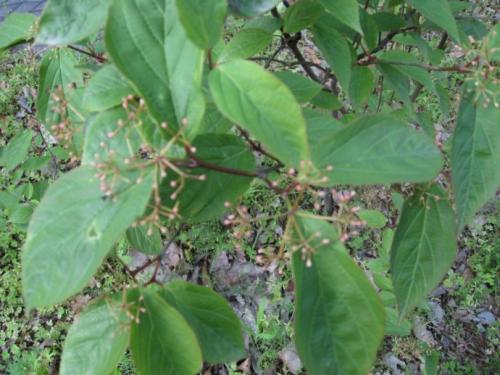Tea viburnum (Viburnum setigerum) profile
Written by admin
Mar 05 2021

Tea Viburnum, scientific name Viburnum setigerum, is a deciduous shrub. Tea Viburnum turns black when buds and leaves dry, and biennial branchlets gray, grayish brown or purplish brown.
Tea Viburnum picture

Tea viburnum info
| Botanical Name | Viburnum setigerum |
| Common Names | Tea Viburnum |
| Plant Type | Deciduous shrub |
| Light | Full sun to part shade |
| Water | Medium |
| Mature Size | 8.00 to 12.00 feet tall, 5.00 to 8.00 feet wide |
| Flower color | White |
| USDA Zones | 5 to 7 |
Morphological features of Tea Viburnum
Stems
Tea Viburnum is a deciduous shrub, up to 4 m tall; Buds and leaves become black, dark brown or grayish black after drying; Current branchlets ar grayish yellow, more or less angular, glabrous, biennial branchlets gray, grayish brown or purplish brown. Winter buds usually less than 5 mm long, up to 1 cm long, glabrous, outer 1 pair of scales for 1/3 to 1/2 of the length of the bud.
Leaf
Tea leaves is papery viburnum, oval oblong to lanceolate, oval dilute ovate or elliptic ovate, 7 ~ 12 ~ 15) cm long, apex acuminate, base rounded, margin base thin sharp sawtooth, except the above early midrib is long cilia, became glabrous, midrib and lateral veins are only below buff grow cilia, a few glands on both sides near the base, lateral veins 6-8 pairs, but almost parallel, straight stretch to the tooth, slightly concave, above the following significantly raised; Petiole of tea viburnum is 1 -- 1.5(~ 2.5) cm long, with a few long undercoat hairs or subglabrous.
Flowers
The inflorescences of Tea viburnum are glabrous or slightly hirsute, with tiny reddish-brown glandular spots, 2.5 -- 4 (~ 5) cm in diameter, often curved and pendulous, the total pedicels 1 -- 2.5(~ 3.5) cm long, usually 5 first radiating branches, peanuts on the third radiating branches, pedunculate or not, aromatic; Calyx tube ca. is 1.5 mm long, glabrous and glandular, calyx teeth ovate, ca. 0.5 mm long, apex obtuse; Corolla of Tea Viburnum is white, tawny or blackish-brown after drying, radiate, 4 -- 6 mm in diam., glabrous, lobes ovate, ca. 2.5 mm long, longer than tube; Stamens are as long as corolla, anthers rounded, minuscule; Style is not above calyx teeth.
Fruit
The inflorescences of Tea Viburnum are pendulous, red, ovoid, 9 -- 11 mm long; The nucleus is very flat, ovoid, 8 ~ 10 mm long, 5 ~ 7 mm in diameter, sometimes remote small, sometimes ovoid moment round, only 4 ~ 5 mm in diameter, uneven, flat abdomen or slightly depressed.
Ecological habits of tea viburnum
Tea Viburnum likes a damp and cool environment, is cold resistant and afraid of dry heat. An acidic soil rich in humus is required. Leaves are prone to atrophy and poor growth under strong light.
Tea Viburnum was born in the sparse forest or thickets on the slopes of valleys and streams, at an altitude of (200 ~) 800 ~ 1650 meters. In scrub, forest, roadside, deciduous mixed forest, valley scrub, valley undergrowth, hillside, hillside scrub, hillside shrubbery, hillside forest, hillside roadside, open forest, water edge.

Tea Viburnum propagation
Sowing propagation of Tea Viburnum should be carried out before budding in early spring, with a semi-cloudy environment is better.
The distribution of tea viburnum
Tea Viburnum is produced in southern Jiangsu, southern and western Anhui, Zhejiang, Jiangxi, northern Fujian, Taiwan, northern Guangdong, eastern Guangxi, Hunan, Guizhou, Yunnan, eastern Sichuan, western Hubei and southern Shaanxi.
The type specimens of Tea Viburnum were collected from Gele Mountain in Chongqing, Sichuan.
Tea viburnum uses
Medicinal value
The roots and fruits of Tea Viburnum are used for medicinal purposes.
Garden use of tea viburnum
Tea Viburnum's branches and leaves are sparse and light. The purple calyx is set off by white flowers. The flowers spread radially on the inflorescence, forming clusters of flowers that are beautiful and touching. Fruit ripe granules red, such as brilliant brocade. tea viburnum is suitable to plant wall corners, pavilion or cluster planted in evergreen forest margin.

Latest Updated
- Benefits of Bugleweed - 7 Science-backed Health Benefits
- Bugleweed Dangers & Side Effects - Is It Poisonous?
- How to Plant Evergreen Trees - What You Should Know
- When to Plant Evergreens - Grow Guide for Evergreen Trees
- 12 Wonderful Evergreen Shrubs for Your Garden
- 12 Popular Evergreen Plants with Pictures for Beginners
- When And How To Prune A Lilac Bush Like a Pro
- How to Grow & Care for Lilac Vine (Hardenbergia Violacea)
- Japanese Lilac Tree (Syringa Reticulata) Care & Propagation Guide
- Shumard Oak Pros and Cons - What to Know
Popular Articles
- Winter maintenance of Antirrhinum Majus
- How to Grow Terminalia Mantaly Tree
- How to Grow and Care for Crossostephium Chinense
- How to grow Antirrhinum Majus in spring
- Peristeria Elata (Dove Orchid) Profile: Info & Care Guide
- Underwatered Snake Plant (Sansevieria Trifasciata) - Signs And How To Fix
- How to Care for Brazilian Jasmine Plant (Mandevilla Sanderi)
- How to Grow & Care for Graptopetalum Purple Delight in Summer
- Rosa Chinensis (China Rose): Plant Growing & Care Tips
- How to Care for Baby Sun Rose (Aptenia Cordifolia)